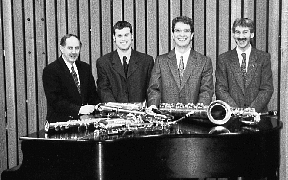|
(Canada)
|
|||||||||
 |
|||||||||
|
|||||||||
|
The Saskatoon Saxophone Quartet was formed in 1982. Since that time the Quartet has performed at the World Saxophone Congresses in Nurnberg, Germany, College Park, Maryland and at the US Navy Band International Saxophone Symposium in Fairfax, Virginia. For a number of years the Quartet performed regularily on CBC regional and national radio as well as on a variety of concert series in Western Canada.
Marvin Eckroth is presently Professor of Music and director of the University of Saskatchewan Wind Orchestra. Prior to coming to Saskatoon, Professor Eckroth was leader of the Edmonton Saxophone Quartet, Saxophone Instructor at the University of Alberta and Professor of Music at Millikin University in Decatur, Illinois. Marvin is a clinician for the Selmer Co. Michael Spindloe has been with the Saskatoon Quartet for nine years. Michael graduated from the University of Alberta where he was a student of William Street. He is owner of Saskatoon's premier independent record store, The Vinyl Exchange. Allen Harrington received a Bachelor of Music Degree from the University of Saskatchewan in May 1999 where he studied with Marvin Eckroth. Allen has the Grand Award Winner at the 1999 Canadian National Music Festival held in Winnipeg. Allen is also a performing Bassoonist and performs frequently with the Saskatoon, Regina and Winnipeg Symphony Orchestras. Troy Linsley received his Bachelor of Music Degree from the University of Saskatchewan where he was a student of Marvin Eckroth. Troy has been an active performer and teacher in Saskatchewan and has bee a member of the Saskatoon Quartet for the past four years. |
|||||||||
|
|||||||||
|
Quatuor, op.31 by Jean Absil was written for the Marcel Mule Quartet in Paris.
Le Quatuor pour Saxophones de Guy Lacour, écrit en 1969, a été créé la même année, dans le cadre du premier Festival de Saint-Denis, par le Nouveau Quatuor de Saxophones de Paris auquel il est dédié – création précédée d'une avant-première à l'O.R.T.F. de Rennes par le Quatuor Melzer. L'oeuvre, en trois mouvements: Elégie, Scherzo, et Rondo final, adopte le langage sériel dodécaphonique avec !a rigueur duquel le compositeur prend toutefois quelque liberté. Analyse: I. Elégie comporte une sorte de présentation individuelle des quatre instruments du quatuor. La série fondamentale (le thème en quelque sorte) est exposée par le saxophone ténor senl et suivie de son renversement au soprano et du renversement de sa récurrence à l'alto. Puis, le baryton entrant à son tour, les quatre parties se contrepointent en une polyphonie serrée, aboutissant à une exploitation fragmentaire, par séquences, de la série initiale. Une cadence prend alors place, tonjours fondée sur la série de base, confiée tour à tour au soprano, à l'alto, au ténor et au baryton, amenant la conclusion à l'issue de laquelle la série amorcée au baryton se termine sur une agrégat formé par la superposition de ses quatre dernières notes. II. Scherzo. Une nouvelle série donne naissance au Scherzo, riche d'effets rythmiques "en chaîne" et d'imbrications inattendues exigeant une savante précision. Il adopte la forme tripartite traditionnelle du scherzo: Scherzo, Trio, Scherzo. Mais son trio, très bref, fait de la superposition de la série initiale du scherzo et de ses renversements, prend l'allure d'un grave choral, atteignant à une âpre expression dramatique. Le retour du scherzo ramène le rythme bondissant et plein d'humour de la première partie et fait appel dans sa coda à une redoutable virtuosité. III. Rondo final. La virtuosité ici touche à son comble, impliquant plus particulièrement la technique du détaché. La coupe, celle du rondo traditionnel, est constituée par l'alternance de refrains et de couplets pouvant s'exprimer schématiquement de la manière suivante: A (Refrain)-B-A-C-A-D-A-B-A-Coda. Le refrain, basé sur une nouvelle série est exposé avec vigueur à l'unisson. Les couplets qui s'insèrent entre ses différentes redites – quatre au total – apportent un apaisement à son âpreté native. Le troisième couplet (D) ramène la série du mouvement initial ponctuée d'éléments empruntés aux second et troisième mouvements. Une éblouissante coda sur la série initiale conclut l'œuvre. –Georges Gourdet |
|||||||||
|